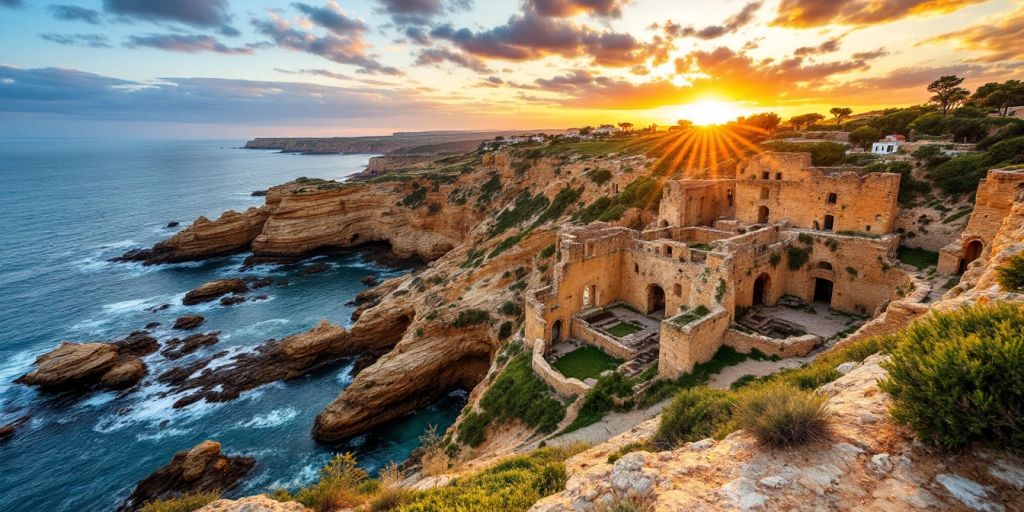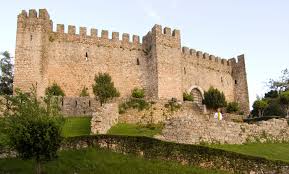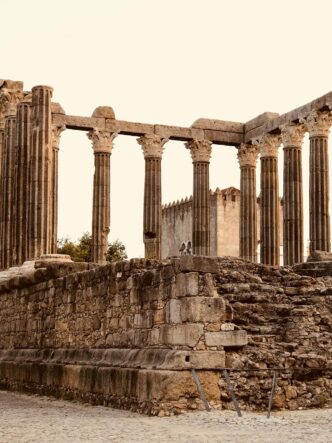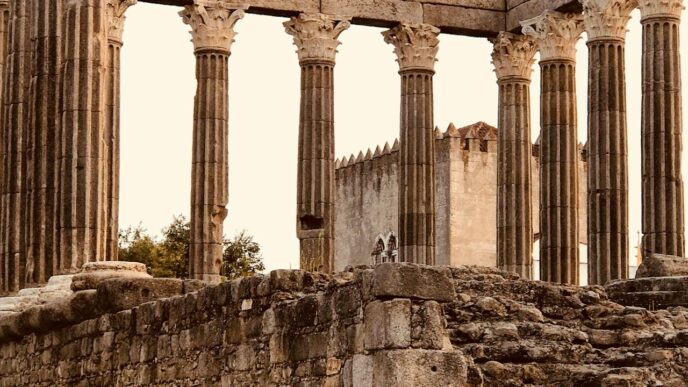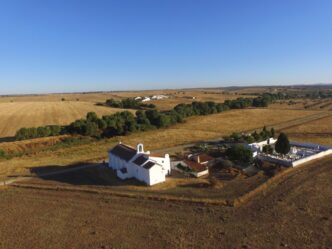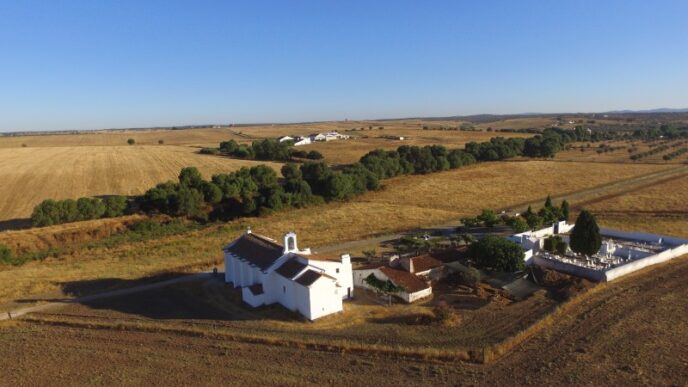The Knights Templar were a powerful group during the Middle Ages, known for their bravery and influence in shaping history. In the Algarve region of Portugal, their presence left a lasting impact that is still felt today. This article explores the origins, key strongholds, and lasting legacy of the Knights Templar in this beautiful region.
The Origins of the Knights Templar in Castro Marim

Early Settlement and Strategic Importance
The Knights Templar first arrived in Portugal during the 12th century. They settled in Castro Marim, a location chosen for its strategic position near the border with the Moorish territories. This area was crucial for the Christian Reconquest, allowing the Templars to defend and expand their influence.
Role in the Christian Reconquest
The Templars played a vital role in the Christian Reconquest of the Iberian Peninsula. They fought bravely against the Moors, helping to reclaim lands for the Christian kingdoms. Their military skills and religious dedication made them a formidable force during this period.
Construction of Castro Marim Castle
To solidify their presence, the Knights Templar constructed Castro Marim Castle. This castle served as a stronghold and a symbol of their power. The castle’s design was influenced by fortifications from the Holy Land, showcasing the Templars’ commitment to their mission.
The Knights Templar not only built castles but also established a network of support that would last for centuries.
Summary
In summary, the Knights Templar in Castro Marim were instrumental in the early days of the Christian Reconquest. Their strategic settlement, military prowess, and architectural achievements laid the groundwork for their lasting legacy in the Algarve region.
Key Strongholds of the Knights Templar in the Algarve

The Knights Templar established several important strongholds in the Algarve, each playing a vital role in their military and religious missions. These strongholds were crucial for the Templars’ influence in the region.
Castro Marim Castle
- Built in the 13th century, this castle served as a defensive structure during the Reconquista.
- Its strategic location allowed the Templars to oversee the surrounding lands and waterways.
- The castle features impressive walls and towers, showcasing Templar architectural style.
Almourol Castle
- Located on an island in the Tagus River, Almourol Castle is one of the most iconic Templar sites.
- It was constructed in the 12th century and became a key military outpost.
- The castle is accessible only by boat, adding to its mystique and defensive capabilities.
Tomar Castle
- Tomar Castle was the headquarters of the Knights Templar in Portugal for several centuries.
- It is famous for its unique architecture, including the Charola, which resembles the Church of the Holy Sepulchre in Jerusalem.
- The castle played a significant role in the Templars’ operations during the Reconquista and later became the seat of the Order of Christ.
The legacy of the Knights Templar is still visible in these strongholds, which attract visitors eager to explore their rich history and architectural beauty.
| Castle Name | Year Established | Key Features |
|---|---|---|
| Castro Marim | 13th Century | Defensive walls, strategic location |
| Almourol | 12th Century | Island fortress, boat access |
| Tomar | 12th Century | Charola, Templar headquarters |
The Influence of the Knights Templar on the Portuguese Empire

Economic Contributions
The Knights Templar played a significant role in the economy of Portugal. They:
- Amassed wealth through land ownership and trade.
- Invested in vineyards and businesses, boosting local economies.
- Helped establish trade routes that connected Portugal to other regions.
Military Innovations
The Templars were known for their advanced military strategies. They:
- Developed new tactics that were crucial during the Reconquista.
- Built strongholds that served as defensive positions against enemies.
- Trained knights who became elite soldiers in the Portuguese army.
Cultural and Religious Impact
The Knights Templar influenced Portuguese culture and religion in various ways:
- They contributed to the spread of Christianity in the region.
- Their architectural styles can be seen in many historical buildings.
- They left behind a legacy of myths and legends that still fascinate people today.
The Knights Templar were not just warriors; they were also key players in shaping the early Portuguese Empire.
In summary, the Knights Templar’s influence on the Portuguese Empire was profound, affecting its economy, military, and culture. Their legacy continues to be felt in modern Portugal, where their historical sites attract many visitors eager to learn about this fascinating chapter in history. Explore the Algarve’s hidden gems to uncover more about their impact!
The Decline and Transformation of the Knights Templar

Arrest and Persecution
In the early 14th century, the Knights Templar faced severe persecution. Under pressure from King Philip IV of France, Pope Clement V ordered the arrest of many Templars. This was largely due to the king’s desire to eliminate their influence and seize their wealth. Many Templars were imprisoned, tortured, and executed, leading to a significant decline in their power across Europe.
Formation of the Order of Christ
In Portugal, the situation was different. Instead of completely dissolving, the Templars transformed into the Order of Christ. This new order inherited the Templars’ wealth and properties, allowing them to continue their mission. Notably, they played a crucial role during the Age of Discovery, with leaders like Prince Henry the Navigator guiding Portugal’s maritime explorations.
Legacy in Modern Portugal
The legacy of the Knights Templar is still felt in Portugal today. Their influence can be seen in various aspects:
- Architecture: Many Templar buildings, like castles and churches, still stand.
- Cultural Impact: The stories and legends surrounding the Templars continue to fascinate people.
- Historical Significance: The Order of Christ helped shape Portugal’s identity during its expansion.
The transformation of the Knights Templar into the Order of Christ allowed their spirit to endure, influencing Portugal’s maritime adventures and cultural heritage for centuries to come.
Exploring Templar Sites in the Algarve Today
Guided Tours and Itineraries
Exploring the hidden gems of the Algarve region is a fantastic way to learn about the Knights Templar. Here are some popular options:
- Templar Day Tours: Many companies offer guided tours that take you to key Templar sites.
- Self-Guided Itineraries: For those who prefer to explore at their own pace, detailed itineraries are available online.
- Local Guides: Hiring a local guide can provide deeper insights into the history and significance of each site.
Historical Landmarks
The Algarve is home to several important Templar landmarks:
- Castro Marim Castle: A strategic fortress with stunning views.
- Almourol Castle: A picturesque castle on an island in the Tagus River.
- Tomar Castle: The headquarters of the Knights Templar in Portugal.
Cultural Significance and Preservation
The preservation of Templar sites is crucial for understanding Portugal’s history. Here are some key points:
- Cultural Heritage: These sites are vital for maintaining the cultural identity of the region.
- Tourism: They attract visitors, boosting the local economy.
- Education: They serve as educational resources for schools and historians.
The Knights Templar left a lasting legacy in Portugal, and their sites continue to inspire curiosity and admiration today.
Myths and Legends Surrounding the Knights Templar
The Holy Grail and Other Relics
The Knights Templar are often linked to the Holy Grail, a legendary object said to hold miraculous powers. Many believe that the Templars discovered it during their time in Jerusalem. This connection has led to numerous stories about their secret missions to protect sacred relics. Some of the most popular tales include:
- The Templars guarding the Ark of the Covenant.
- Hidden treasures beneath Solomon’s Temple.
- The Templars’ role in the Freemasons‘ origins.
Conspiracy Theories
Over the years, various conspiracy theories have emerged about the Knights Templar. Some of these include:
- The Templars were involved in a secret society that still exists today.
- They possessed knowledge that could change the world.
- Their wealth and power led to their downfall, as they were seen as a threat to kings and popes.
Popular Culture References
The Knights Templar have made their way into movies, books, and games, often depicted as mysterious and powerful figures. Some notable mentions are:
- The film National Treasure, where Templars protect a hidden treasure.
- Dan Brown’s The Da Vinci Code, which explores Templar secrets.
- Video games like Assassin’s Creed, where players interact with Templar lore.
The legends surrounding the Knights Templar blend fact and fiction, creating a rich tapestry of stories that continue to captivate our imagination.
The Architectural Marvels of the Knights Templar
Unique Design Elements
The architecture of the Knights Templar is truly remarkable. They combined various styles, creating structures that are both functional and beautiful. Some key features include:
- Thick stone walls for defense
- Intricate carvings that tell stories
- Large windows to let in light
Symbolism in Structures
Many Templar buildings are rich in symbolism. They often used designs that reflected their beliefs and values. For example:
- The cross symbolizing their faith
- Circular shapes representing eternity
- Star patterns that signify divine guidance
Famous Templar Buildings in Portugal
Portugal is home to several famous Templar buildings. Here are a few notable ones:
- Convent of Christ in Tomar
- Castro Marim Castle
- Almourol Castle
The Templars left behind a legacy of stunning architecture that continues to inspire awe today. Their buildings are not just structures; they are a testament to their faith and dedication.
In summary, the architectural achievements of the Knights Templar reflect their unique blend of military strength and spiritual devotion.
Conclusion
The story of the Knights Templar in the Algarve is a fascinating mix of history and legend. From their brave battles during the Crusades to their lasting impact on Portugal’s growth, their legacy is still felt today. The Templars were not just warriors; they were also skilled leaders who helped shape the country. Their impressive castles and churches, like the Convento de Cristo, remind us of their power and influence. Even though the Templars faced challenges and were eventually dissolved, their spirit lives on in the places they built and the stories they left behind. Exploring these sites offers a glimpse into a remarkable past that continues to capture our imagination.
Frequently Asked Questions
What were the Knights Templar?
The Knights Templar were a group of soldiers and monks who formed in the 12th century to protect Christian pilgrims in the Holy Land.
Why did the Knights Templar come to Portugal?
They came to help the early Portuguese kings during the Christian Reconquest, which aimed to reclaim land from Muslim rule.
What is the significance of Tomar for the Knights Templar?
Tomar was where the Templars built a major castle in 1160, which became their headquarters in Portugal.
What happened to the Knights Templar in the 14th century?
In the 1300s, the Templars were disbanded by the Pope, but in Portugal, they transformed into the Order of Christ.
Are there still sites related to the Knights Templar in Portugal?
Yes, many castles and churches linked to the Templars can be visited today, especially in the Algarve region.
What is the legacy of the Knights Templar?
The Knights Templar left behind impressive buildings and influenced Portugal’s history, including its exploration and trade.

